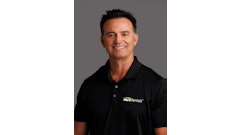
Are you in the market for an aerator? There's lots to consider before making your selection.
Aeration is the process by which plugs of soil are removed with a series of tines arranged on wheels, as in the case of rolling aerators, or through the use of a mechanical drive that slams the tines in and out of the ground in a vertical motion. Either type can be equipped with coring or solid tines.
Core aerators have hollow shafts or tines that enter the ground and pull out a core or dirt plug and drop it on the surface. Spike aerators use solid tines that poke holes into the soil.
Bob Brophy, director of lawn products at Turfco Mfg., says, "Coring tines are the best type of aeration, as they remove a plug of soil and leave it on top of the ground to break up slowly. Also, the hole where the core has been removed will take a longer time to close up, thus allowing air, water and nutrient passage for a longer time."
Experts generally agree that using a core aerator is the best way to expose the grass roots to sunlight, water and nutrients. In addition, cored holes retain water so the soil requires less watering. Core aeration also helps reduce soil compaction. Less compaction means a healthier root system, therefore a stronger plant. The lawn will become more tolerant to heat, drought and traffic as well as more disease resistant.
What to look for
"Quality and durability attributes are often subject to the user and their needs," says Linda Beattie with Schiller Grounds Care, makers of Classen & Ryan brand aerators. "Some attributes to consider are heavy-duty construction, steel tines, commercial engines and easy-to-operate control systems. Other features might include fold-down handles, drive wheel systems for ease in transport and operation of the unit, steering capabilities and trailers designed to transport the unit."
According to Drew Coates at Billy Goat, durability, performance and factory support are the three most important features.
"Durability is number one because if the rental professional can't keep the unit out on rent, they are not making money. Performance is number two because if the customer is happy with the way the machine performed and how easy it was to do the job, they will be a repeat customer. The last thing is factory support. Every unit breaks down eventually from wear and tear, neglect, accidents, abuse, etc. How quickly can you get the unit back up and running and making you money? A company that is rental specific, with personnel designated to only handle rental companies, can better ensure that your equipment investment is going to consistently continue to make you money," Coates says.
Nathan Antons, national sales manager at SourceOne Outdoor Power Equipment, points to simplicity and ease of operator use as significant items to look for in an aerator. "Equipment that is broken-down is revenue lost," he says. "Equipment that is hard to operate reduces repeat rentals."
Take it easy
Aerators today are being designed to not only do a quality job of aerating but also greatly reduce operator fatigue. There are walk-behind aerators designed to steer around corners and obstacles, eliminating the need to lift up on the aerator to maneuver a turn. With less lifting required, a lawn care professional is physically capable of aerating more lawns in one day. These same aerators that steer are being designed also to allow the operator to stand on the aerator versus walking behind it. With this stand-on type, more jobs can be done in the same window of time. And more jobs for the lawn care professional mean more rentals for the rental business.
Some manufacturers offer exclusive features that go a long way toward simplifying the use of their aerators. Bluebird International, for example, features its patented free-wheeling outside tines on its aerators. The center tines are fixed, while the outer tines are free to move in order to facilitate turning and minimize turf damage.
In addition, there are split-tine models, where one half of the tines are driven by one hand control while the other half are controlled by the other hand. This also assists with turning and in fact, makes it possible to turn the machine with the tines in the ground.
Coates at Billy Goat suggests paying attention to details when selecting an aerator. "Look for internally greased and sealed motorcycle-style chains and pillow block bearings," he advises. "These are important because when units get power washed, cheap chains and bearings will eventually rust up and take your unit out of service. These features point to durability, which in turn helps your bottom line."
The bottom line for rental businesses is really how simple the machine is to use and maintain. If the machine is intuitive to operate, there will be less misuse and that, in turn, means less maintenance.




















